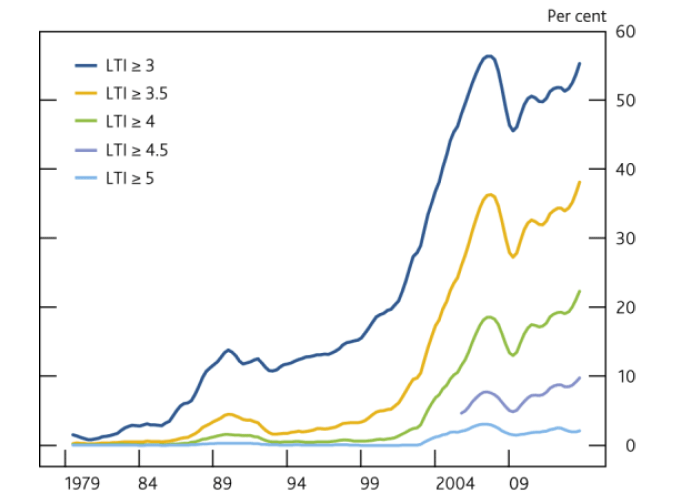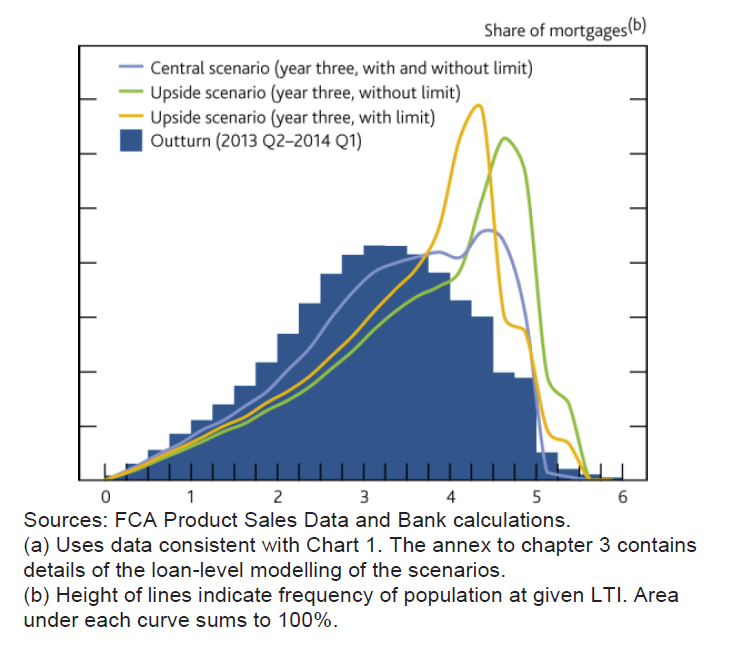The UK Financial Policy Committee is is charged with taking action to remove or reduce systemic risks with a view to protecting and enhancing the resilience of the UK financial system. In their June 2014 report they highlighted that the recovery in the UK housing market has been associated with a marked rise in the share of mortgages extended at high loan to income multiples. Increased household indebtedness may be associated with a higher probability of household distress, which can cause sharp falls in consumer spending. Falls in consumption can in turn weigh on wider economic activity, increasing macroeconomic volatility in the face of shocks to income and interest rates. Furthermore, rapid growth in aggregate credit – which could be associated with a sharp increase in highly indebted households – is strongly associated with subsequent economic instability and the risk of financial crisis. Acting against excessive indebtedness will make the financial system more stable.
As a result, the FPC decided at its June meeting to recommend to the Prudential Regulatory Authority (PRA) and the Financial Conduct Authority (FCA) that they take steps to ensure that lenders constrain the proportion of new lending at loan to income (LTI) ratios at or above 4.5 to no more than 15% of the total number of new mortgage loans. This is because they believe the the aggregate effect of many firms undertaking such lending could pose a risk to financial stability.
They recommend:
“The PRA and the FCA should ensure that mortgage lenders do not extend more than 15% of their total number of new residential mortgages at Loan to Income ratios at or greater than 4.5. This recommendation applies to all lenders which extend residential mortgage lending in excess of £100 million per annum. The recommendation should be implemented as soon as is practicable.”
The PRA have now released a detailed consultation paper on implementing this recommendation. They are intending to implement the recommendation as soon as practicable. The proposed implementation date for these rules is 1 October 2014. The proposed rules would have the effect of limiting to no more than 15% of the total the number of mortgage loans completed by each lender at or greater than 4.5 times LTI. The limit is intended to restrict but not halt the extension of mortgage lending at such LTIs and can thus be thought of as a limit on the flow of very high LTI lending. The measure is designed to capture risks associated with excessive household indebtedness. Lenders will be required to report on this dimension. This relates to mortgages written, not offers made, or decisions in principle. Remortgages are buy-to-let mortgages are excluded. They provide data on the split by LTI in the UK, showing the trends. They also show scenarios for the potential impact of the policy. If house prices and mortgage approvals grow in line with the central scenario, the impact of the policy action is likely to be minimal. However, if there is more underlying strength in the housing market than in the central scenario, the proposed rule would be likely to restrict the availability of very high LTI mortgages to some households. The proposed policy might then reduce the level of GDP in the short term to the extent that it acts as a binding constraint on mortgage lending. However, even in the upside scenario considered in the June 2014 FSR, the size of the effect would be small (roughly 0.25%). The main benefits of the policy will be to reduce macroeconomic volatility and the likelihood and severity of financial instability.
They also show scenarios for the potential impact of the policy. If house prices and mortgage approvals grow in line with the central scenario, the impact of the policy action is likely to be minimal. However, if there is more underlying strength in the housing market than in the central scenario, the proposed rule would be likely to restrict the availability of very high LTI mortgages to some households. The proposed policy might then reduce the level of GDP in the short term to the extent that it acts as a binding constraint on mortgage lending. However, even in the upside scenario considered in the June 2014 FSR, the size of the effect would be small (roughly 0.25%). The main benefits of the policy will be to reduce macroeconomic volatility and the likelihood and severity of financial instability. Two observations for the Australian market. First, we have no macro-prudential policies here despite the fact that they are recommended by several global bodies. Second, the LTI metric is recommended as the policy of choice, and in Australia we do not see regular reporting of LTI data from the banks via APRA or ABS. Given the high income multiples here, we should be following the UK. In addition the regulators should start to capture and report LTI data.
Two observations for the Australian market. First, we have no macro-prudential policies here despite the fact that they are recommended by several global bodies. Second, the LTI metric is recommended as the policy of choice, and in Australia we do not see regular reporting of LTI data from the banks via APRA or ABS. Given the high income multiples here, we should be following the UK. In addition the regulators should start to capture and report LTI data.

4 thoughts on “UK To Cap High Loan To Income Mortgage Loans”